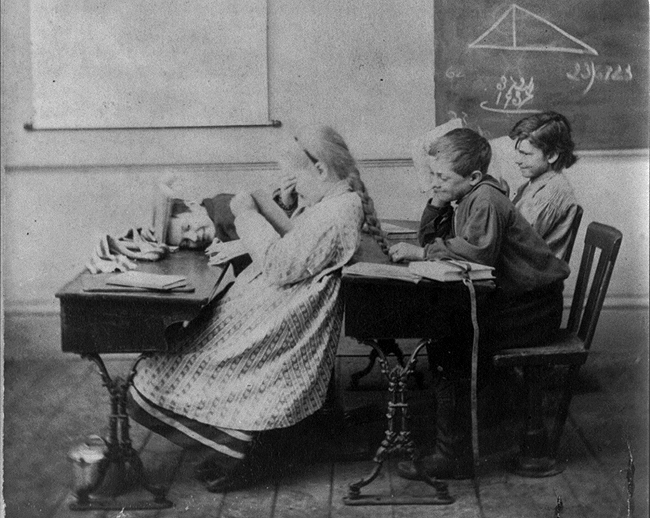Stop Penalizing Boys for Not Being Able to Sit Still at School
More news that points out the obvious.
Something is rotten in the state of boys’ education, and I can’t help but suspect that the pattern I have seen in my classroom may have something to do with a collective failure to adequately educate boys. The statistics are grim. According to the book Reaching Boys, Teaching Boys: Strategies That Work and Why, boys are kept back in schools at twice the rate of girls. Boys get expelled from preschool nearly five times more often than girls. Boys are diagnosed with learning disorders and attention problems at nearly four times the rate of girls. They do less homework and get a greater proportion of the low grades. Boys are more likely to drop out of school, and make up only 43 percent of college students. Furthermore, boys are nearly three times as likely as girls to be diagnosed with Attention Deficit and Hyperactivity Disorder (ADHD). Considering 11 percent of U.S. children–6.4 million in all–have been diagnosed with a ADHD, that’s a lot of boys bouncing around U.S. classrooms.
A study released last year in the Journal of Human Resources confirms my suspicions. It seems that behavior plays a significant role in teachers’ grading practices, and consequently, boys receive lower grades from their teachers than testing would have predicted. The authors of this study conclude that teacher bias regarding behavior, rather than academic performance, penalizes boys as early as kindergarten. On average, boys receive lower behavioral assessment scores from teachers, and those scores affect teachers’ overall perceptions of boys’ intelligence and achievement.
Read more HERE
WHY FATHERHOOD MATTERS
Fatherhood is also classically aspirational. It’s a marker of class, pure and simple. Fatherlessness is a real crisis even as fatherhood gains this wild significance. In 2008, 41 percent of births involved unmarried women compared with 28 percent in 1990. Fatherlessness as a condition has been linked with virtually every social ill you can name (the big exception being lesbian families): Young men who grow up without fathers are twice as likely to end up in jail, 63 percent of youths who commit suicide are from fatherless homes, and 71 percent of high school dropouts come from fatherless homes. What these connections mean — particularly whether fatherlessness is a symptom of poverty or a cause — is the subject of complex debate. Neither political party is willing to deal with the consequences of the connections, though. The Left looks the other way, fearing the stigmatization of single mothers and wallowing in the vestigial critique of family structure as a whole. The Right loves to talk about “family values” but lives in a fantasy about what those values are. It is astonishing how much the conservatives of the moment talk about the family and how little they understand about how contemporary families actually work. I suppose they must retain their indulgent vision of 1950s men and women. Otherwise, they might have to ask themselves what the cost of arresting every black man who ever took a puff of marijuana and separating them from their children might mean for those communities. They might have to think about maternity and paternity leave.
If conservatives ever did stop to look at contemporary families and contemporary fatherhood in particular, they might discover a source of great strength. The appeal of fatherhood, its newfound position as a requirement of the good life, is that it is a real duty. It binds you to other people. It binds you, for real, to a woman. It is the only thing that still can. Sex is basically an exchange of pleasantries now. Marriage is instantly reversible, a negotiable contract. But fatherhood is real.
Read more HERE
Myths Surrounding Children And Divorce
Myths About the Effects of Divorce on Children: By Cathy Meyer, About.com Guide
In the early 1970’s, Judith Wallerstein, began to study the effects of divorce on children. She studied a group of 131 children and their families who were going through the divorce process over a period of 25 years. In her book, The Unexpected Legacy of Divorce: A 25 Year Landmark Study, published in 2000, we learn that children really aren’t “resilient” and that divorce leaves children to struggle for a life-time with the residue of a decision their parents made.
According to Ms. Wallerstein, “If the truth be told, and if we are able to face it, the history of divorce in our society is replete with unwarranted assumptions that adults have made about children simply because such assumptions are congenial to adult needs and wishes. The myths that continue to guide our divorce policies and politics today stem from these direct attitudes.”
In other words we have become a society of adults who put their own needs and happiness before the emotional well-being of their children and justify it all by buying into the myth that children are resilient or time heals all wounds.
Myth #1: If Parents Are Happy Their Children Will be Happy Also :
I’m sure you have heard someone say that if they divorce and are able to lead a happier life that their children will be happier also. The idea behind this myth is that a happy mom or dad automatically means happy children.
People who use this justification are projecting their own feelings onto their children. They are objectifying their children out of a need to find happiness for themselves without having to feel responsible for causing their children emotional pain. They are failing to understand that, though they may be unhappy, their children are probably quite content and don’t care if their parents don’t get along as long as their family is together.
When you introduce a child to the world of divorce, you are altering every aspect of their life. That kind of change is hard to adjust to for adults. Imagine what it must be like for children who are not old enough to reason and intellectualize the situation?
Fact:
Children of divorce are more aggressive toward their parents and teachers. They experience more depression, more learning difficulties and problems getting along with their peers. They are three times more likely to be referred for psychological help. They become sexually active earlier, they are more likely to produce children out of wedlock and they are three times as likely to divorce themselves or to never marry.
A child’s happiness is not dependent on their parent’s happiness. A child’s happiness stems from routine, having a home, two parents, friends to play with, school activities to be involved in and being able to count on those things being constant day in and day out.Myth #2: The Less Animosity And Bitterness The Less Trauma :
It is true that fighting and conflict exacerbate the trauma but there are those who believe that if they are able to get along then there children will suffer no lasting negative effects from the divorce. There seems to be a universal belief that the children will end up happy and content with their new life as long as the parents aren’t fighting.
Because of this belief, we focus on the process and not the aftermath of the process. We feel that our energy should be put toward making sure things run smoothly for the children during the process and once we are beyond that we don’t have to worry about any possible negative effects on our children.
Fact:
This misguided belief is not only harmful to our children but to the adults involved in the divorce process also. Divorce, at it’s best cannot be considered an amicable process. No matter how hard we try there will be bad feelings. Most divorces are not unilateral. One or the other parent is going to feel betrayed and hurt. Those feelings will trickle down to the children no matter how hard you try to conceal them. To think that all will be fine as long as the divorce process goes off without a hitch is unwise for all involved.
According to Ms. Wallerstein,”the parent’s anger at the time of the breakup is not what matters most. Unless there was violence or abuse or high conflict, a child has dim memories of what transpired during this supposedly critical period.”
In other words, what causes the most pain and long-term negative effects for children of divorce is the sadness of their family breaking up, the anger they were not able to express, having to adjust to one parent no longer living in the home. The loss of control over activities because of forced visitation, the loss of two full-time parents in their lives, the sadness they feel around friends from intact families is what concerns a child, not how well his divorced parents are getting along.
It is the aftermath of divorce, not the process of divorce that does our children the most harm. Don’t buy into the belief that once the process is over all will find a happy ending. Focus not only on the process but on what needs to be done after the process to help the children and adults move forward with as little emotional harm as possible.
Better yet, focus on building relationship skills that will help you repair your marital problems and keep yourself and your children out of the Family Court System.
Read original here:
http://divorcesupport.about.com/od/childrenanddivorce/p/childrenmyths.htm?rd=1
Divorce Civil Rights

by Joseph E. Cordell Divorce lawyer and founder of DadsDivorce.com
As a society, we find profiling — painting a group of people with such a broad brush — to be wholly unacceptable.
Except when it applies to men in family courts.
Quite frankly, men’s rights has become a civil rights issue. When you think of the progress we’ve made in civil rights, men’s rights as it pertains to the family have been neglected.
Profiling of different groups based on skin color, age, disabilities, etc., is not permissible. We regard these generalizations as being deplorable in virtually every sphere of civil rights, but for some reason these generalizations and assumptions are permissible as they pertain to men in domestic scenarios.
There is an institutional family court bias, but we can’t simply blame judges. Sure, they are human beings and have preconceptions like everyone else, but it goes much further than that.
The family law industry as a whole — from attorneys to social workers — makes presumptions about men and fathers.
Historically, women have usually been the primary nurturers. Judges and opposing counsel can quite persuasively argue that statistically moms more often than not are the ones that are the primary caregivers.
Yet the problem with stereotyping, as civil rights leaders pointed out, is that stereotypes are built on probabilities that do not give fair opportunity to others, to the innocent in that group.
Ironically, the feminist movement, which was largely in response to men’s cultural and economic dominance, cast aside men whose roles in family courts were already tenuous. Dads were victims of being male at a time when the movement was not sympathetic to their position.
Men generally were less the subject of the civil rights movement than the obstacle, and for that reason there weren’t many sympathetic ears turned toward men, particularly in family court.
As a result, a group think has emerged that has unfortunately elevated the interest of women above the interest of men.
Read more HERE
Permanent Alimony Hurts Women
Permanent Alimony. Truly a thing of the past, or soon to be. Here are some quotes from a great article I saw online and some videos that drive home the point. Alimony needs reform – no doubt about that. Why? I feel the truth of the injustice of permanent alimony is starting to be revealed. It is now affecting women, and we know that anything that negatively affects women gets put on the front burner. Men, regardless of what radical feminists might think, are chivalrous. We want to help women and do not want to see them suffer in any way. We will go out of our way to change laws to make sure women are taken care of, even if in the long run it will hurt us – like permanent alimony and punitive child support orders historically have been hurting men.
Alimony is no longer going to be a gendered thing. With “marriage equality” on everyone’s minds, we will start to see alimony become part of the discussion among gay marriage advocates. Right now it is about “love” and “equality.” That is great. But….when you start to see marriage for what it really is (a legal and business arrangement), you see how complex marriage can be when things do not go as planned. What happens IF things go wrong. What happens IF you take the risk of being a stay at home parent? What happens IF you want out and want to get remarried? Think about this and think about how your situation will be handled with your possible future ex.
I’m happy to see people are seeing the reality and the veil has been lifted on this outdated legal trick. Read on and listen to what is really going on in the new Millenium. Times are changing…thank GOD!
The Great Alimony Myth
Are you expecting permanent or long-term alimony?
By Cathy Meyer
I received an email recently from a reader who wanted out of her “abusive marriage.” The only problem, she and her husband are both unemployed. She was distraught because she had no money to file for divorce or support herself after a divorce.
Like so many women, she was under the impression that if she divorced she would receive alimony BUT she was in a quandary because her husband had no income to pay this assumed alimony.
She asked me, “Will a judge make him work and pay me?” I responded by telling her that a judge could order him to get a job but, it was up to her husband whether or not a job was acquired. I also told her that a judge could suggest that she also get a job and support herself.
There is a myth that women have about alimony and long-term marriages. It is believed that if you divorce after a long-term marriage that your ex-husband will be financially responsible for you with court ordered permanent alimony.
Alimony laws are state specific with each state handling the matter in a different manner. A few decades ago it was common for a woman to be given permanent alimony after a long-term marriage. That is no longer the case.
[youtube=http://www.youtube.com/watch?v=a57sLsyXEFc&w=560&h=315]
Alimony in The Twenty First Century:
The standard in most states today is rehabilitative alimony which is paid for a certain duration and gives a woman time to “rehabilitate” herself financially post divorce. Specifically this means taking college courses if she has no marketable skills or re-entering the workforce and rebuilding her career post divorce. Basically it is support while she has the opportunity to “get back on her feet.”
Texas and Mississippi award alimony only to marriages of 10 years or more and only for a short period of time. Utah will not grant alimony past a time period equal to the duration of the marriage, and Kansas curbs its durations at 121 months.
The last state in the country to continue to award long-term or permanent alimony, Massachusetts, is now (2011) reforming their alimony laws to catch up with the rest of the country. If the reform passes, alimony payment timelines will be based on the number of years a couple was married.
For instance, if a couple was married less than five years, the duration of alimony could only be half the number of months of the marriage. If a couple was married for 10 to 15 years, the maximum term alimony could be awarded for would be 70 percent of the time they were married. A judge would only be allowed discretion to award alimony indefinitely in marriages over 20 years.
I guess you could say that alimony reform has swept the country and, like it or not women who have been out voiced by men who run state legislatures have to suck it up and keep their expectations low when it comes to what or if they will receive alimony after a divorce.
[youtube=http://www.youtube.com/watch?v=vdT8KcDxFdI&w=420&h=315]
The Great Alimony Myth:
According to Beverly Willett, Vice Chairman of the Coalition for Divorce Reform, “The financial risk stay-at-home parents face when it comes to alimony is even more troubling. When no-fault was instituted, permanent alimony awarded to spouses who had given up their careers to become stay-at-home parents began to fall out of favor, permanent alimony being deemed incompatible with the clean break idea behind no-fault.”
And therein lies the myth, if you are a stay-at-home parent who gave up your career to raise the children you have a right to permanent alimony. According to Ms. Willett if two parents agree to one parent staying home then that agreement should be legally binding after the divorce. And due to that belief women all over the country are angry because they have to become financially responsible for themselves once the divorce is final or the short-term alimony runs out.
Take Joan for instance. Her husband was ordered to pay alimony for 7 years because Joan had been a stay-at-home mother, had given up her career and when she wanted a divorce thought it her ex-husband’s place to support her because they had come to the agreement that she give up her ability to remain financially responsible for herself.
Joan’s alimony term is about to come to an end and she is in a panic because, instead of returning to the work-force or going back to college and rebuilding a career she has been skating by and surviving on alimony.
Joan believes the laws should be changed so that women like her can receive permanent alimony and never have to face the financial hardship she is now facing. Joan is a healthy, intelligent 45 year old woman. Her son is now in college, her child rearing days are behind her but she feels her ex-husband should still be held responsible for her, “lifestyle.”
[youtube=http://www.youtube.com/watch?v=jWeBYru9sek&w=560&h=315]
read more HERE




